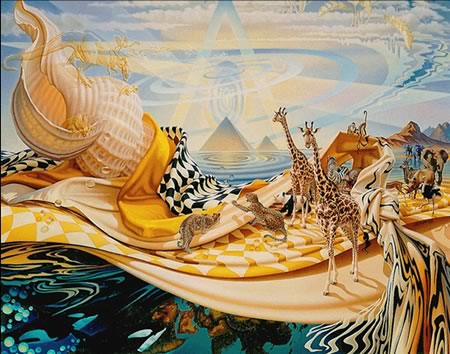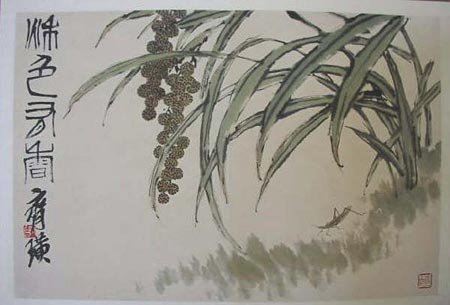
I mentioned in my post on Jacek Yerka that contemporary artists who become fascinated with the work of a particular Surrealist seldom produce work of note.
Just to prove that all rules have an exception, sometimes a shining one, there are the beautiful paintings of Ilene Meyer.
Meyer is obviously fascinated with the work of Spanish Surrealist Salvador Dali, he of the soft watches, infinite checkered plains, Freudian hallucinations and atomic deconstructions of old master paintings.
Meyer’s work also carries influences of Indian mandalas, science fiction artists, “psychedelic” artists like Alex Gray and other contemporary “Surrealists”.
I hesitate to use that word because it’s usually used inaccurately, and I would be incorrect in applying to Meyer’s work. Dali and the other Surrealists were concerned with images from the subconscious mind and were looking to shock and disturb. Meyer, despite her fascination with Dali, is looking to engender wonder and visual pleasure, quite a different intent, but fans of fantastic art can appreciate both.
Meyer’s paintings are laced with iconographic images from Dali’s oeuvre, including obvious homages such as the aforementioned soft watches, as well as her versions of Dali’s “Atomic” period objects that are sliced or “exploded” into neat segments, the infinite checkered plains (that she likes to curve into impossible topologies), distant mountains soaked in blues and oranges, serrated blocks of color defining complex forms, classical architectural forms re-rendered in impossible materials and “skins” of land or sea that reveal worlds hidden beneath.
But she is not mimicing Dali, merely taking the influences, making appreciative references and carrying the themes off into her own direction.
She also has repeated themes of her own, including a fascination with European style clowns and jesters, transparent objects, heads of medusa, icons of chance and gambling, pyramids, glassy spheres, luxurious tropical plants, African wildlife (particularly giraffes and zebras), radiant patterns in skies or the surface of objects, landscape surfaces that are curved and folded like cloth, and objects and surfaces that swoop, swirl and blend into one another as if melting together or being pulled apart like taffy.
One could complain that this is sort of a grab-bag of clichéd “surreal” imagery, but Meyer paints it with such enthusiasm, verve and obvious joy, that it rises above any such concerns into a kind of worship of the richness of the visual world.
Her web site, Meyerworld, has a fairly wide selection of her work and is divided into sections: “The Senses”, “The Elements”, The World”, and “The Soul”.
The images are just large enough to get a little taste of her work, but only a taste. If you find it appealing, you should look for the much larger and better reproductions in the collection of her work, Ilene Meyer: Paintings, Drawings, Perceptions.
Addendum: Ilene writes to mention that a new book has just been released (November 2006), illustrated by her and written by D. Michael Tomkins, called The World Below. The book has its own site here.
Addendum 2: Ilene Meyer is having her first gallery showing in the U.S. in ten years at the Arts Partnership Gallery in Tuscon, AZ (125 S. Arizona Ave., 624-9977) from January 12 to February 10, 2007.
Link suggestion courtesy of Jack Harris.

 Esao Andrews’ work fits loosely into a branch of contemporary fantastic art called “pop surrealism”.
Esao Andrews’ work fits loosely into a branch of contemporary fantastic art called “pop surrealism”.


